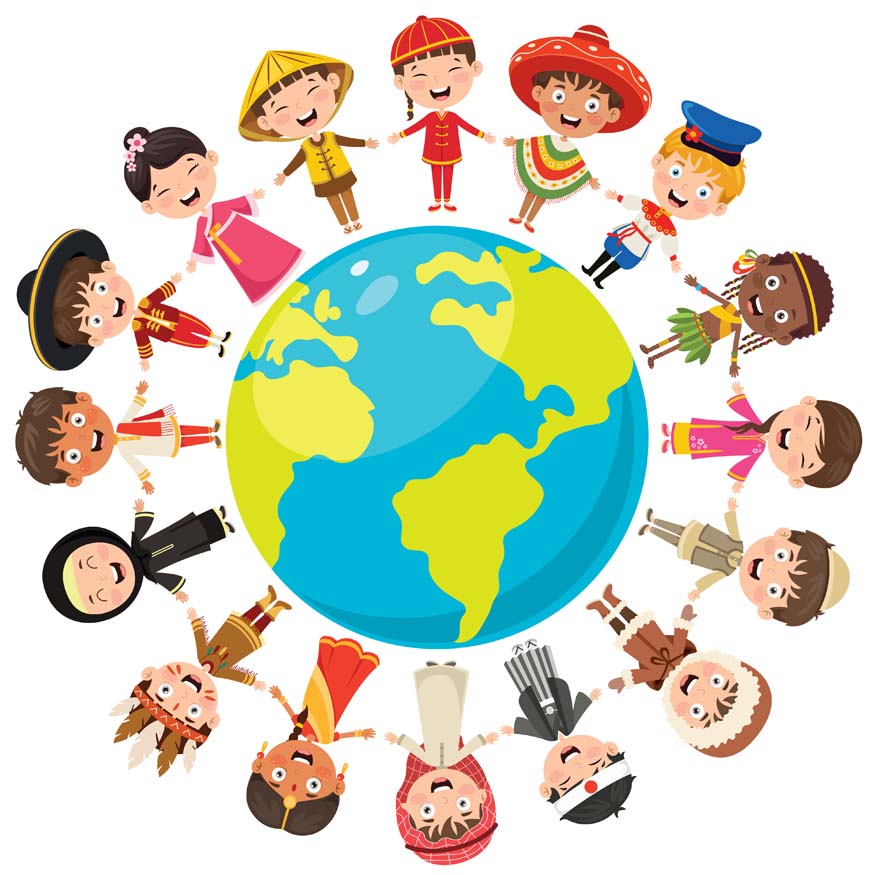Teaching Children About World Religions
In today’s globalised world, understanding various cultures and beliefs is vital. Educating children about different religions fosters empathy, respect, and acceptance. This article will explore the different types of religions, the names and signs of different religions, and the dress of different religions. We will also discuss why these aspects are essential for children to learn.
Now let’s dive deeper into the names and signs of different religions:
Different Types of Religions
Christianity
Beliefs and Practices
Christianity is based on the teachings of Jesus Christ. Followers believe in the Holy Trinity, consisting of the Father, Son, and Holy Spirit. Practices include prayer, Bible reading, attending church services, and observing sacraments like baptism and communion.
Signs
The cross symbolises the crucifixion and resurrection of Jesus Christ. Various denominations have different variations of the cross.
Dress
Attire varies across denominations. Catholics may wear a crucifix, while clergy wear specific vestments during services. Modesty in dress is emphasised in some denominations.
Islam
Beliefs and Practices
Islam’s core beliefs revolve around the Five Pillars: Shahada (faith), Salat (prayer), Zakat (charity), Sawm (fasting), and Hajj (pilgrimage to Mecca).
Signs
The crescent and star symbolise Islamic faith. The call to prayer and mosque architecture, with minarets and domes, are also unique signs of Islam.
Dress
Muslim women may wear a hijab, niqab, or burqa, and men may wear traditional thobes. Modesty is highly emphasised, and clothing must cover most of the body.
Hinduism
Beliefs and Practices
Hinduism embraces a wide array of beliefs, including karma, dharma, and moksha. It is polytheistic, with worship of gods like Vishnu, Shiva, and Durga.
Signs
The Om symbol represents the universe’s vibration. Temples often contain intricate carvings and are sites of pilgrimage and celebration.
Dress
Traditional clothing includes sarees for women and dhotis for men. During religious ceremonies, specific colours and ornaments may be worn.
Buddhism
Beliefs and Practices
Buddhism focuses on the Four Noble Truths and the Eightfold Path to achieve enlightenment. Meditation and mindfulness are core practices.
Signs
The Dharmachakra, or Wheel of Dharma, represents the cycle of birth and rebirth. Buddha statues, often depicted in various mudras (gestures), are common in temples.
Dress
Monks and nuns wear simple robes, usually in shades of orange or maroon. Lay followers wear modest clothing during temple visits.
Judaism
Beliefs and Practices
Judaism emphasises the Torah’s laws and ethical living. Observances include the Sabbath, kosher dietary laws, and holidays like Passover.
Signs
The Star of David is a well-known Jewish symbol. Menorahs and mezuzahs are also common in Jewish homes.
Dress
Orthodox Jewish men wear kippahs and black hats, while women may wear modest dresses. Tzitzit (fringed garments) and Tallit (prayer shawls) are worn during specific rituals.
Sikhism
Beliefs and Practices
Sikhism teaches the oneness of God and humanity’s equality. Guru Granth Sahib’s teachings are central, emphasising honesty, humility, and community service.
Signs
The Khanda represents spiritual and temporal balance. Gurdwaras, or temples, have a unique architectural style, with the Golden Temple being a famous example.
Dress
Men wear turbans, signifying spirituality and honour. Women wear traditional Punjabi suits. The Five Ks (Kesh, Kara, Kanga, Kachera, Kirpan) are essential for baptised Sikhs.
Let’s further explore some indigenous and less common religious traditions, along with the importance of teaching children about these aspects.
Indigenous and Lesser-Known Religions
Shintoism
Beliefs and Practices: Shintoism, mainly practised in Japan, centres on kami (spirits) present in natural phenomena. Ritual purity and harmony with nature are key concepts.
Signs: Torii gates mark the entrance to sacred spaces. Ritual objects include mirrors, swords, and jewels.
Dress: Traditional Shinto priests wear white robes and headdresses, while followers may wear kimonos during festivals.
African Traditional Religions
Beliefs and Practices: These religions vary across tribes and regions but often include ancestor veneration and nature worship.
Signs: Masks, sculptures, and drums are used in rituals and ceremonies.
Dress: Beads, animal skins, and colourful fabrics often signify different roles or statuses within the community.
Native American Spirituality
Beliefs and Practices: Native American beliefs vary among tribes but often focus on a deep connection with the land and nature.
Signs: Totems, dreamcatchers, and animal symbols represent spiritual concepts.
Dress: Feathers, shells, and intricate beadwork often adorn ceremonial clothing.
Importance of Teaching Religious Diversity to Children
Cultivating an Inclusive Mindset: By teaching children about different types of religion, including those less commonly understood, they develop a more inclusive and accepting mindset. This lays the foundation for empathy and mutual respect.
Encouraging Critical Thinking: Understanding the beliefs, signs, and dress of different religions encourages children to think critically. They learn to recognise cultural symbols, draw connections between beliefs and practices, and appreciate the diversity that enriches our global community.
Developing Cultural Competency: Cultural competency isn’t limited to understanding the major world religions. Recognising indigenous and local religious traditions broadens children’s horizons and equips them to interact respectfully with people from various backgrounds.
Promoting Peace and Harmony: Education about the different types of religions can be a powerful tool in promoting peace and harmony. By acknowledging the similarities and respecting the differences, children grow into adults who can engage in meaningful dialogue and cooperation across religious and cultural divides.
Building Empathy and Respect: By introducing children to the names of different religions, their signs, and dress, they learn to recognize and respect diversity. Teaching children about the different types of religion can foster curiosity, acceptance, and empathy.
Enhancing Cultural Literacy: Cultural literacy includes understanding the different types of religion. This knowledge helps children navigate multicultural environments, preparing them for global citizenship.
Mitigating Prejudice: Prejudice often stems from ignorance. When children learn about all the different religions and their practices, it minimises stereotypes and misconceptions.
Conclusion
The rich diversity of world religions, including both prominent faiths and lesser-known traditions, offers a treasure trove of knowledge and cultural insight. The signs and dress of different religions not only symbolise spiritual beliefs but also reflect a civilization’s art, history, and identity. Whether exploring the serene practices of Buddhism or the vibrant rituals of African traditional religions, this comprehensive view of global spirituality serves as a beautiful testament to human creativity and the quest for meaning.
At EuroKids Preschool, we believe that teaching children about these various aspects not only enriches their education but also fosters a world where empathy, respect, and understanding flourish.











